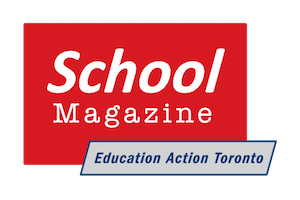What is happening to our most vulnerable students?
What is happening to the most vulnerable students in our schools? It’s true that kids may be vulnerable for all sorts of reasons – poverty, underfunding of schools, systemic racism and misunderstanding of different cultures to name a few. But there are at least 358 000 young people that the province acknowledges require special teaching or treatment or accommodation for a wide variety of needs. The Elementary Teachers Federation of Ontario (ETFO) released a report on special education just last month outlining the policy, funding and ideological decisions that have led to a state affairs in which a more students receive less support than they did 20 years ago while teachers, often helpless to meet their needs, face burnout1.
This dire situation for overlooked young people is illustrated by the tragic death of 16 year-old Landyn Ferris, a grade 10 student at Trenton High School. Landyn was in a programme for kids with complex needs and according to his family’s lawyer, had Dravet Syndrome, a form of epilepsy which can result in prolonged, frequent and severe seizures. Brandon’s family alleges that, contrary to his mother’s warning, he was left alone in a room. He was unresponsive when someone came to tell him it was time to go home and later pronounced dead. Nearly a year later, the public still doesn’t know what happened. His name isn’t even noted in the recent update provided by the Hastings and Prince Edward District School Board; he is just a “student in a life skills programme at Trenton High School.” That speaks volumes about the care and concern for high needs students supplanted by bureaucratic avoidance from a school board worried about a possible lawsuit.
David Lepofsky, head of the Accessibility for Ontarians with Disabilities Act Alliance, (AODA Alliance) has called for a Coroner’s inquest into Brandon’s death, since there is still little information about its circumstances or what could have been done to avoid it. Lepofsky’s group and its predecessors have been fighting since the late 1970’s to see basic standards of care and accountability applied throughout the province for Ontarians with disabilities. It is grinding work in a province that should be able to do much better.
The Ford government made it clear, yet again, in its recent throne speech that it wants to see “back to basics” happen in the classrooms. What does this mean for kids who need more?
What about Inclusion in the regular classroom?
Specialized education and treatment are labour intensive. Consider a child in a regular classroom who learns quite differently from peers. The implications are about as varied as the number of kids who fit that description. So, here’s an example:
A child we can call Sam is identified by a formal board process called an Identification Placement and Review Committee (IPRC) as a student with a learning disability. This, in the Ministry of Education’s (MOE) view means that Sam, despite average intellectual ability, normal hearing and vision is affected by an undefined neurodevelopmental disorder that makes it difficult to learn how to read and/or write and/or do math and/or organize.
The ETFO special education report cites Ministry data indicating that Sam might well be spending more than half of the day in a regular class along with the other 87 percent of kids who learn differently or need different supports.
Teaching Sam is not a simple matter of extra worksheets and repetition. They might spend whatever time is available with a specially trained resource teacher, but Sam could very well need a teacher with even more training and experience with myriad issues like memory, awareness of sounds, attention to detail, organization of thoughts – it’s a world in itself. This teacher needs to be able to spend time 1:1 with Sam, helping them process something as simple as a word, learning how to break its sound segments into readable parts. In practical terms, Sam’s learning disability is a manifestation of the fact that regular teaching methods haven’t worked. It takes time and focus to figure out how to find methods that do. Each of the many kids in Sam’s position are like an “n of 1 study.” You run a trial of teaching or management, test out its effects, adjust; do another trial and so it goes.

Not surprisingly, according to the ETFO report, the Ministry favours inclusion of special needs kids in the regular classroom. There is substantial support for this idea. Why put a kid who already feels inferior to others in a special class that might make them feel worse? Scholarly journals have many articles on this issue of inclusion.2
But such articles stress the difference between responsible and irresponsible classroom inclusion – something the ETFO report also explains. It isn’t just a matter of placing a special needs child in a classroom and giving the teacher, who is teaching 25 other kids, some professional development, then leaving things at that. It’s delusionary to think that this teacher has the time to provide the direct hands-on teaching and support for a specific child or children who need it.
The question is: what is the least intrusive programme that will meet a child’s special needs? That environment could be a regular classroom with some modifications to enable that child to manage. It might include some withdrawal to a specialist teacher with the expertise to work on the skills needed. But the plan changes as regular methods become less effective at addressing whatever needs that child has or may develop. If there isn’t a range of effective and readily accessible supports from regular classroom placement to a special programme outside that class, children aren’t included; they are abandoned.
Where are the teachers who used to provide that support? Sadly, Ontario school boards shed 4 990 teachers from their classrooms between 2018-19 and 2024-25. Ricardo Tranjan, of the Canadian Centre for Policy Alternatives (CCPA) explains that between those years the number of Kindergarten teachers per 1000 student declined from 95 to 90; for students in grades 4-8 it was from 54 to 52 and in secondary classes that ratio dropped from 74 to 70. So where are these inclusionary classes supposed to get the extra support they need to help these children who need specialized support?
ETFO argues that the Ministry needs to fund and place a hard cap of 24 kids on grades 4 -8 classes and 26 for Kindergarten. For example, grades 4- 8 classes are funded by the Ministry for an average size of 24.5 – that’s average for the school board, not the specific school. This means that a class of grade 8 students could be as high as 30, with special needs kids in it waiting for assessment or waiting for support.
Yet, even this doesn’t clear up the practical problem of how to work with kids whose needs are so different. In its Annual Ontario School Survey People for Education notes that regular staff shortages in schools across the province mean that special education teachers are filling in for absent colleagues for whom principals can’t find a replacement. Every day nearly 50 percent of schools at both the elementary and secondary panels are short education assistants needed to help in classrooms with special needs kids.
What about money?
Funding pervades this discussion. The Mike Harris PC government of the 1990s and early 2000s rivals even that of Doug Ford for its radical interventions in funding public goods. After amalgamating 129 school boards across the province into 72, it was time to create a one-size- fits-all funding formula. Economist, Hugh Mackenzie, was sounding the alarm about this as long ago as 2018. The funding formula has never addressed the varied ad hoc costs school boards face across the province for which they are perennially underfunded. The squeeze on schools that resulted, “deprived programmes like special needs, physical education, music, art, drama and library services of adequate funding. There was an anti-liberal arts education and special needs bias built into the funding formula that has yet to be redressed.”
Two authors of the ETFO report, Ricardo Tranjan and Carolina Aragao, argue that the payment per pupil across the province is actually less than it was in 2018 when the Ford government took over: $1 500 for each pupil now – despite what Ford says about spending more on education – if you take inflation into consideration. 3
actually less than it was in 2018 when the Ford government took over: $1 500 for each pupil now – despite what Ford says about spending more on education – if you take inflation into consideration. 3
According to the ETFO report, current special education funding in Ontario operates along similar lines. Tranjan noted recently that 87 percent of this funding is based on what the province decides to pay per-pupil based on overall enrolment along with an estimate, based on a predictive statistical model, of the number of kids in a school board who likely need special education support. None of the above is based on a count of actual breathing children who need a lot of help. Thirteen percent of the total $3.7 billion allocated in 2024-25 is based on actual assessed – and very high- needs of real kids.
There are few staff to help many complex students. The ETFO report provides examples of what school boards can offer. For example, the Greater Essex County DSB has 1 special education teacher for every 15 of its special education students, 1 education assistant for every 10 children in the same position and 1 specialist like a speech/language pathologist, social worker, child and youth worker or psychologist for every 16 enrolled as special education students. This is at the high end of the support continuum. Further down the list is Niagara DSB with 1 special education teacher for 24 kids, 1 education assistant for every 11 enrolled special education kids and 1 specialist for every 46 students in that position. The Toronto DSB, unfortunately, can offer only 1 teacher per 109 enrolled special education students, 1 education assistant for 17 such students and 1 specialist for 55 students needing specialized support from a psychologist or similar professional.4
On average this all boils down to:
Special education classroom teacher: 1 hour and 30 minutes per week, or
Educational assistant: 2 hours and 30 minutes per week, or
Specialists: between 1 hour and 1 hour and 30 minutes per week
As Tranjan and Aragao argue, this doesn’t mean that special needs children receive that help:
“ For example, 2 hours and 30 minutes with an educational assistant means that the classroom teacher of a regular class with three children with special education needs would have an educational assistant once a week. The other four days of the week, the teacher is alone in the classroom, with a funded class average of 24.5 students for grades 4 to 8, including the three children with special education needs”5
Funding is influenced somewhat, by the extent of a child’s needs. A student like Landyn Ferris, with serious medical needs could not be left alone. A school board could apply for a separate amount of money called a Special Incidence Portion (SIP). As of the 2022-23 school year, if the board could show that the child needed more than 2 full-time staff, the government could grant it the maximum allowance of $28 803 – enough for about half the salary of one education assistant. So, the board needs to make do with what the Ministry gives it for special education, maybe pull funds from other accounts or dip into reserve funds. It means boards’ resources are spread thinner with fewer supports for kids in classrooms or for those waiting for assessments to prove they need supports.
As the ETFO report notes, the special education allotment per pupil has declined from $930 in 2018 to an inflation-adjusted $860 during the pandemic and is slowly making its way back up to about $910 – still below where it used to be. ETFO calls for special education funding to be indexed to the inflation rate.
What about government indifference?
It’s not just about the money, David Lepofsky explained to me in an interview. He is not only head of the Accessibility for Ontarians with Disabilities Act Alliance, (AODA Alliance) but chairs the Toronto DSB Special Education Advisory Committee (SEAC). He understands legislation and government avoidance of issues surrounding accessibility of public institutions. He is a lawyer and is blind – an advocate for others struggling in an intractable system. The AODA Alliance has pushed for years to get the government to enact the accessibility standards outlined in reports from K-12 Education Standards Development Committee and the Post-Secondary Education Standards Development Committee. The many recommendations include providing learning materials designed for kids with disabilities, timely assessment of needs and standard accessibility requirements for schools across the province that addresses the needs of all young people with disabilities: those with mobility, hearing or vision loss, autism, developmental issues and so on.
Lepofsky told me that the government has been sitting on this report for three years. He also noted work by Ford government appointee Rich Donovan, who, in his 2023 report on the Accessibility for Ontarians with Disabilities Act, declared a crisis in accessibility across the province. There is no meaningful enforcement of standards, basic leadership, sense of urgency or ownership of the challenges posed by accessibility needs. Government and private business leaders told him incorporating needs of those with disabilities was not a priority. The province, he wrote, would not likely meet its deadline of 2025 to become fully accessible.
Meanwhile, in the legislature on November 25, 2024, Minister for Seniors and Accessibility Raymond Cho declared that “88 percent of Ontarians believe Ontario is accessible.”6 Job done as far as the Tories are concerned.
The first step in dealing with any crisis is acknowledging it.
Getting Access to help
Students who need help in class usually get some. That might be the classroom teacher changing something simple- like extra time for finishing work, explaining a task in a different way. If that’s not working the Ministry of Education says that this child may be deemed by their school board to need a special education programme or services and require an Individual Education Plan (IEP). The IEP involves plenty of time, consultation, follow-up and a plan on how to deal with an actual child. The Ontario Autism Coalition (OAC) describes it as a roadmap to consider strengths and needs, to collaborate with parents and other supporters and outline accommodations, modifications to curriculum and programmes like social skills learning “to provide equitable access to learning opportunities and support…”
The IEP is a fine idea, but only as good as educators’ capacity to follow it. An OAC survey of special education students and their families during the 2023-24 school year, reported that 54 percent of families believed that some or none their child’s IEP was followed consistently and that 65 percent had rarely or never had a follow-up discussion about it. Interesting to note is that 69 percent of those reporting had their special needs kids placed in the regular classroom.
The OAC says the Ministry needs to pare the current special needs assessment backlog, so that there is a clear idea of who needs support and how much they need: information about actual students that may be used to develop a better funding formula. But there is another roadblock. Assessments leading to a formal identification of a child’s needs rely on availability of a school psychologist. In a study released last year by People for Education (P4E) only 26 percent of over 1 000 Ontario elementary schools reported that they had regular access to a psychologist – the lowest number since P4E began reporting that figure. The situation is worse for schools in low vs high income neighbourhoods.
Not getting access to proper help
What do you do as you watch your children go off to school every day with that sick feeling about what they’ll face? As they fall further behind, will they get into trouble, a reprimand or a trip to the school office? Parents worry about their kids, no matter what the challenges. But for parents who know their challenges are serious, it’s the feeling that enough isn’t being done that is so hard to take.
Parents reported in the OAC survey above, that most of their kids were placed in a regular classroom – with or without support. Twenty-seven percent of their children were placed in a specialized congregated classroom for those who needed a lot more support. About half of the parents surveyed said their child’s placement was appropriate, but a sizeable number of them (39 percent) didn’t think their kids were in a classroom that suited their needs. Over half of them reported that they weren’t satisfied with the academic support received by their kids. As the report adds: “many families indicate they feel schools are underfunded/under-resourced to the point where they cannot provide proper academic support, they are merely trying to keep students safe.” 7
 For children on the autism spectrum, the waitlist for treatment including applied behaviour analysis and speech/language support was over 73 000 as of last September. Parents and allies of these young people have been fighting for years to get the Ford government to reduce the size of that list, but the situation is worse not better.
For children on the autism spectrum, the waitlist for treatment including applied behaviour analysis and speech/language support was over 73 000 as of last September. Parents and allies of these young people have been fighting for years to get the Ford government to reduce the size of that list, but the situation is worse not better.
You certainly get some idea of the situation in schools from the quotations from teachers throughout the ETFO report: “ We’re allowed, no matter what the size of the school is – and ours is a large school- two psychological assessments a year.
Toronto SEAC held a town hall meeting for parents last November. As David Lepofsky said , it was a “game changer.” Parents told their and their children’s stories:
A child diagnosed with an attention deficit and learning disability late despite parent’s advocacy. Kids with a learning disability need a dedicated specialist teacher, not someone sent into the classroom for a while.
A student on the autism spectrum – could be disobedient and violent , but parent not involved in the safety plan. Accommodations for the plan couldn’t be done in school.
It can take 2-3 years to get an assessment.
A young person with attention and learning problems spent weeks in the school office. They have no friends. What the Board says it’s doing is lip service.
The assessment waitlist is years – family had to get one done privately. They say their child’s grades are inflated – don’t actually reflect skills
A parent is told that for her child to get support, it will have to be taken from another child’s pocket of help.
Staff turnover meant that a parent had to explain time and again why their child, whose needs had already been certified, needed help
Another young person with sensory sensitivity is labelled and shamed by others in the school.
It goes on. The desperation parents expressed was palpable.
Safety
That desperation doesn’t just rest on parents, but on teachers. Jennifer Pinder is a Special Education Resource Teacher at the Waterloo DSB. She’s had a lot of experience within that board as a support teacher for 25 schools and works with ETFO presenting workshops on Autism Spectrum Disorder. She spoke at the launch of the ETFO report in March and later talked with me about class evacuations. Teachers have a duty of care to all their students to protect them from physical and emotional risks. Sometimes a child might be having a lot of difficulty managing their emotions and reactions in a regular class. Sometimes, that might present a risk to others in classroom without supports or programming. And that problem could lead to a teacher conducting a class evacuation.
There would be in place a safety plan for such a child and Pinder described what might trigger a class evacuation: transitions from one class or subject to another, feeling like they’ve been left out, a change in routine – this sort of thing. Teachers might know it’s time to move the other students for example, when the child sings a certain tune. They have code words for the other students when it’s time to leave and have someone come and supervise the child left in the classroom.
Jennifer Pinder is certainly passionate about balancing the special needs of kids in the classroom against safety. She describes how carefully teachers debrief their students after an evacuation, even the kindness and consideration classmates show towards the peers in difficulty: “There’s a level of community that is inherently found with each other especially when it’s modelled by teachers. But then there’s the flip side, which is the normalization of all of this happening.”
Realistically, this is not a solution for assessment backlogs, fewer appropriate placements and early intervention to catch problems before they become untenable.
Four out of five ETFO members surveyed in 2023 said that violent incidents are increasing and that they’re getting worse. They disrupt working and classroom learning conditions; most teachers in the survey reported that there are too few education assistants, social workers and child/youth workers on hand to help students who need support. Again, it’s about access to help.
Exclusion
Without good access to supports and programmes, schools may exclude students from attending school. A child might be having a particularly hard time coping with whatever stresses have presented themselves, loses control and the principal decides to call a parent to come and take them home. A student’s designated education assistant might be off sick. The principal worries that they might not be able to cope and makes a similar call. These actions are taken, at least on the surface, with parental permission and are called “soft-exclusions.” Another form of soft exclusion is that of a modified school day when parents and the principal agree to have their child attend part-time.
 Then there are hard exclusions, when a school principal acts according to duties under Ontario’s Education Act (section 265m.1 ) ” …to refuse to admit to the school or classroom a person whose presence in the school or classroom would in the principal’s judgment be detrimental to the physical or mental well-being of the pupils.” This is supposed to be a last resort; other interventions have been tried but haven’t worked. It is supposed to come with a plan for providing an education for the student. After all, students do have a right to attend school.
Then there are hard exclusions, when a school principal acts according to duties under Ontario’s Education Act (section 265m.1 ) ” …to refuse to admit to the school or classroom a person whose presence in the school or classroom would in the principal’s judgment be detrimental to the physical or mental well-being of the pupils.” This is supposed to be a last resort; other interventions have been tried but haven’t worked. It is supposed to come with a plan for providing an education for the student. After all, students do have a right to attend school.
Ministry Data obtained by The Trillium through a Freedom of Information request reveals that 499 elementary and secondary school students were formally excluded from school throughout 2022-23 for a total of 11 776 days. That’s a lot of lost days, being away from teaching, daily routines and peers.
What about accountability? David Lepofsky told me that, in 2020, the AODA Alliance asked all 72 school boards across the province to share policies and procedures concerning exclusions. Only half of them responded. Even then, there were a lot of different approaches for handling the issue. The Ministry isn’t doing anything about this and in many cases, Lepofsky thinks “each principal is a law unto themselves” in absence of any board policy or procedure. In 2018 the Toronto DSB, after pressure from SEAC, did set out rules for exclusions, but 6 years later won’t say how many exclusions are issued. This according to Executive Superintendent Jim Spiropoulos is because this might identify students if shared publicly. Yet, the data need not contain any identifiers like the names of the school or young people involved.
What’s the real reason for scanty information here? Is an accurate count just not available to central staff? Are the number of soft and hard exclusions as well as kids on modified school days higher than the Board cares to admit? It’s not difficult to supply that information.
Lepofsky adds: “You could and should post on the website of the board and communicate to parents that every child has the right to be in school. If your child has been told they cannot be in school, here’s the phone number to call.”
For years, the Ford government has peddled the notion of back-to-basics education, as though teaching basics is some kind of novel idea. It’s been clear from the beginning that Doug Ford is really talking about creating a workforce that is set to go for whatever requirements he imagines business might need. Like all the other public goods Ford has cut, he has cut education and with that, access to special supports and teaching that our most vulnerable young people need. At a Toronto SEAC meeting back in January this year, parent Leo Lagnado spoke of critics who “… reduce individuals to productivity, judging their worth on their ability to generate profit and efficiency. And this is a very narrow view of worth which is inherently ableist since it excludes and marginalizes those who do not fit into the normative conception of productivity – to which the school system is closely tied.”
Whatever, back-to-basics means, it has little room for those who don’t fit in.


